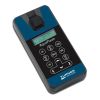Turner Designs CyanoFluor Handheld HAB Indicator
Features
- Estimate abundance of cyanobacteria
- Excellent sensitivity and repeatability with results in <30 seconds
- Handheld, battery powered instrument with internal data logging
- Expedited repair and warranty service
- Lifetime technical support
- More
Overview
The Turner Designs CyanoFluor Handheld HAB Indicators is a field-portable fluorometer that can quickly estimate the abundance of cyanobacteria in a mixed algal population using PC (phycocyanin) to CHL (chlorophyll) ratios. Monitoring PC to CHL ratios over time enables users to predict the onset of HABs and leverage resources to mitigate their harmful effects.
Calibration
CyanoFluor is factory-calibrated, meaning no calibration is required; RFU values can be correlated to µg/L using conversion coefficients. Solid-state optoelectronics ensure long-term instrument stability. CyanoFluor’s intuitive functions, small size, and internal data storage make it an ideal field instrument for HAB monitoring.
Lab Package Includes:
- CyanoFluor handheld HAB indicator
- Storage pouch
- 1 each 10x10mm glass cuvette
- 10 each filter capsules
- Data download cable
Field Package Includes:
- CyanoFluor handheld HAB indicator
- Carrying case
- 2 each 10x10mm glass cuvettes
- 60cc sampling syringe
- 10 each filter capsules
- Calibration check standard
- Data download cable
- Storage pouch
- Kim wipes
In The News
Lake Erie Volunteer Science Network: Building Trust in Citizen Science Programs
Citizen science programs have popped up across the United States, focusing on connecting local communities with nearby water resources and building a trustworthy data pool over the sampling period. While commonly utilized as a means of ensuring that large watersheds or lake regions are adequately sampled, the credibility and success of such programs have been called into question. [caption id="attachment_38996" align="alignnone" width="940"] HRWC volunteers measure stream velocity across a subsection of Woods Creek, a tributary of the Huron River near Belleville, Michigan. Stream velocity measurements can be combined with water level measurements to calculate stream flow and chemical parameter loads.
Read MoreMonitoring Lake Erie’s Eastern Basin: Building Long-Term Data and Real-Time Public Solutions
In the eastern basin of Lake Erie, off the coast of Dunkirk, New York, a data buoy collects valuable water quality, weather, and wave data that inform residents and regulatory groups of conditions on the water. Since 2011, Buffalo State University’s Great Lakes Center has maintained and operated the Dunkirk buoy with funding from the Great Lakes Observing System (GLOS) and field support from the NYSDEC Lake Erie Fisheries Research Unit. [caption id="attachment_38976" align="aligncenter" width="940"] The Dunkirk Buoy viewed from the research vessel after being deployed in early spring.
Read MoreSonTek CastAway-CTD Meter Review
Lightweight and easy to use, the SonTek CastAway offers a convenient 3-in-1 solution for measuring conductivity, temperature, and depth profiles. At a 5 Hz sampling rate, the CastAway is designed for up to 1 m/s free-fall through the water column. With fast response and accurate conductivity, temperature, and depth measurements, the CastAway is ideal for thermocline and halocline profiling. The unit also reports salinity and speed of sound. [caption id="attachment_38732" align="alignnone" width="940"] Environmental scientist, Katelyn Kubasky, holding the SonTek CastAway in front of the pond at the Fondriest Center for Environmental Studies.
Read More







